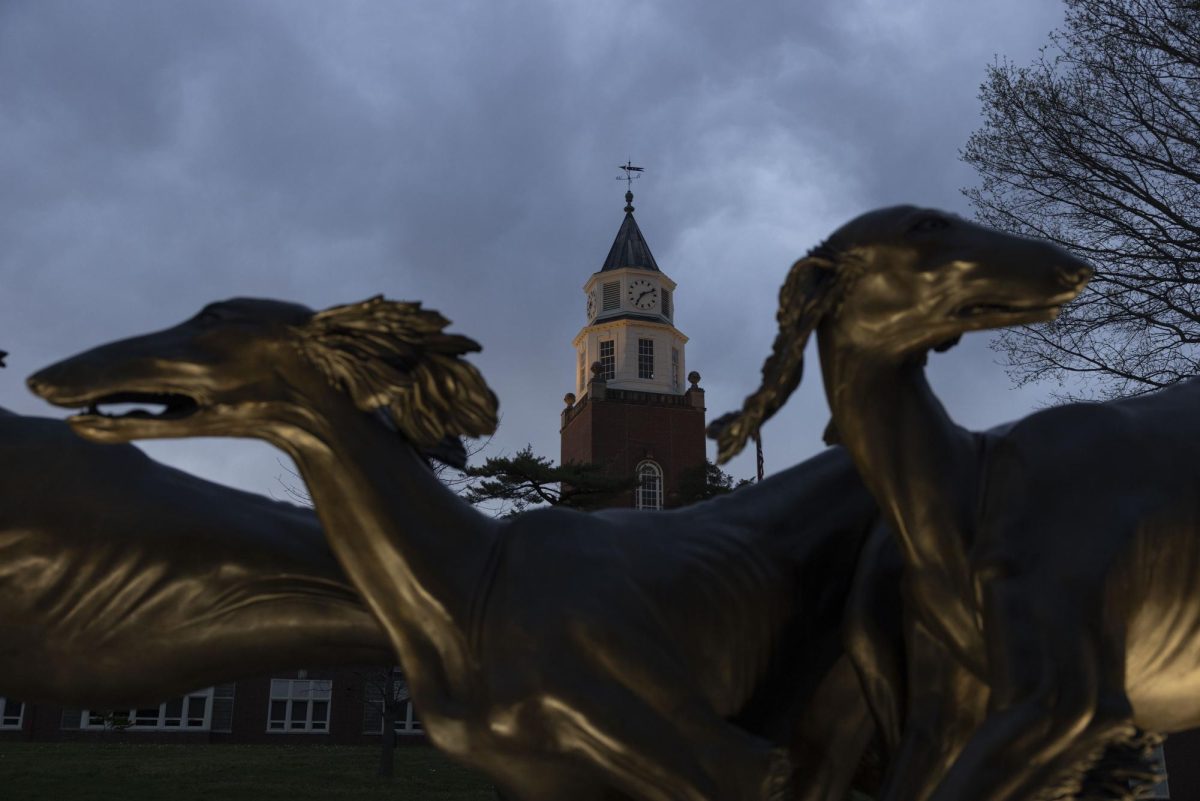The Dark past of the panthers
February 28, 2002
Shoot out a dark chapter for local Black Panther Party.
The first gun shot blasts were heard just before daylight.
By 6 a.m. on a brisk Thursday November morning in 1970, residents of the 400 block of North Washington Street in Carbondale would awaken to an ongoing stream of gunfire. More than half a dozen squad cars surrounded the house at 401 N. Washington St., where members affiliated with the Black Panther Party resided. The nearly three-hour standoff between Carbondale and SIU Police forces and three house occupants would result in five people suffering serious gunshot wounds, five more with minor injuries, and damage to houses and cars parked along the bullet-riddled street. The shootout between police and members of the Black Panther Party is remembered by some who were here at the time. Though not a positive aspect of Carbondale’s history, it’s a reminder that black activism and empowerment is sometimes unfortunately linked to violence. Recent incidents involving the Carbondale Police Department and black residents namely the macing of black SIUC students at a party in April 2001 forced local residents to the Carbondale streets in protest. The 1970 shootout would also leave an indelible mark on the student-led organization that had been a positive force in the community up to that point.
Advertisement
The National Black Panther Party began in 1966 as a self-defense group. Young men would patrol black neighborhoods, observing police conduct and protecting residents from acts of police brutality. Originally named the Black Panther Party For Self-Defense, the organization started in Oakland, Calif. Party founders Bobby Seale and the late Huey P. Newton eventually turned the group into a quasi-militant political organization, calling for blacks to take up arms in self-defense. Other philosophies included exempting blacks from entering the draft, which was still ongoing as America was deeply embroiled in the Vietnam War in 1966.
They considered themselves armed revolutionaries, said John Holmes, SIUC lecturer in Black American Studies, who helped the Panthers as they called themselves establish a free breakfast program at the Olivet Free Will Baptist Church. It was one of many community-based programs started by the National Black Panther Party in cities across the country. Holmes also helped organize the Black Studies Program in 1968.
At their core, the Panthers fought against police brutality sometimes at the risk of their lives. Donning black leather jackets, dark sunglasses and black berets, the Panthers had a formidable, and some say threatening persona. At its peak, Panther membership exceeded 2,000 with party chapters in several major cities, including Chicago, Detroit and St. Louis. It attracted mostly young black men and women.
There was no official chapter in Carbondale. But some SIUC students from Chicago and St. Louis started their own organization in town that was heavily influenced by the party. The National Committee to Combat Fascism (NCCF) began around 1969. Group members included 20-year-old Chicagoan Donald Jackson and Thomas Archie Dotson, 20, from East St. Louis. The group loosely affiliated themselves with the national party.
Some of them were students of mine, Holmes said. They were taking Black Studies classes when it was housed in the Old Baptist building. We had all sorts of literature and magazines; Mohammed Speaks the Nation of Islam newspaper, The Black Panther Newspaper and the Chicago Defender. The guys would come by and get literature, and take part in discussion groups.
The NCCF, whose membership was sporadic, had an office on the corner of North Washington and Oak Street. Some members of the group lived upstairs in a house at 401 N. Washington St. near Green Street. The group did not organize on campus, instead focusing on the surrounding community. In addition to creating community programs, the group sold Black Panther Newspapers, and other propaganda. No formal marches or demonstrations were organized in Carbondale. They did urge local residents to arm themselves, which often fell on deaf ears, according to Holmes.
They were teaching these young people how to use weapons and were preaching things like people need to arm themselves. I took some of the guys to the homes of people I knew who hunted and had weapons. It wasn’t for attacking the police, or to defend themselves from the police. People already had shotguns and rifles in their houses. So the propaganda of people needing to arm themselves didn’t have much meaning to the people in this community, he said.
Advertisement*
That fact did not stop the Panthers from agitating the community and the police. Echoing the national party’s doctrine, they often referred to the police as pigs and accused them of using streetlights to maintain surveillance on the oppressed population, in Carbondale, despite the fact that local residents years earlier petitioned to have streetlights put up. Members of the NCCF reportedly went around town shooting out streetlights to the disapproval of many black residents.
Whether NCCF members Jackson, Dotson or others were involved in the streetlight shootings is uncertain. Still, these acts would undoubtedly catch the attention of local police. Police would then deny giving any extra or increased surveillance of the group, or of having any knowledge that it was affiliated with the Black Panther Party. In fact, there were no incidents of harassment or overt tension between the police and the group. Yet, the events that transpired in the early morning of Thursday, Nov. 12, 1970, would bring the local police and Panthers to a near deadly confrontation.
According to witness and police accounts, and Daily Egyptian archives, the gun battle began an hour prior to the standoff on Washington Street. An SIU squad car was patrolling an area near Illinois and Grand Avenues. At around 5 a.m, the two officers spotted a Volkswagen van parked near the railroad tracks. The vehicle appeared to be abandoned or stalled. Flashing a spotlight inside the van, the officers saw what appeared to be a person asleep and slumped on the seat. The officers proceeded to back their car up behind the van.
Suddenly, the van pulls away, turning north on Illinois Avenue. The police pursue. The chase ends as the van stops several blocks later. The officers radioed in to report the incident. According to police accounts, a man jumped out came to the back of the van and fired two shots with a pistol into the passenger side. In the midst of the melee, the unidentified man reportedly fired three or four more shots, as the officers abandoned their car, hitting one in the hip. Carbondale police were notified, receiving a description of the man, who was later spotted in the north end of town near Marion and Oak Street.
Arriving at the scene, another officer tried to apprehend the suspect. According to police accounts, the man fired off a shotgun round in the face of the officer, causing pellet wounds to the face. No more than a half hour later, the man was traced to the house on 401 N. Washington St., after the officer, wounded from the shotgun blast, radioed for back up. By 5:45 a.m., at least four Panthers had barricaded themselves inside, having sandbagged the upstairs windows. The shootout lasted for nearly two hours.
It was a nightmare, said Margaret Nesbitt, who was awakened by the shooting while in her home near Marion and Washington Street just down the block from where the standoff occurred.
It went on and on. The only thing that saved us was daylight, and the embarrassment of the police. That’s why they stopped shooting, she said.
Other neighbors came out of their homes, including a 55 year-old man named Jesse Russell, who lived across the street at 402 N. Washington St. Russell was shot in the shoulder after stepping on his front porch. He survived the injury, but the source of the shot was not known. The area was not evacuated by police, according to witness accounts. Nesbitt, who wishes not to reveal her age, is still troubled by events some 30 years later.
Police eventually tear-gassed the house, but with little effect. The men would climb onto the front porch roof to try and get air and climb back into the window, according to witness accounts. Neighborhood residents reportedly shouted at police to let someone try and talk the men out. The battle ended soon after Carbondale resident Elbert Simon Carbondale’s first black postmaster general who knew the men in the house convinced police to allow him into the house to try and get them to surrender. After an hour inside, Simon and three other community members who later entered the house talked the men into surrendering. James K. Holley, also known as Badatuade Dmowali, 20, Michael Johnson, also known as Milton Boyd, 22, and Leonard Thomas, 20, were escorted from the house and arrested for the shootings.
Two other men, Joseph Brown no relation to SIUC Black American Studies Director Joseph Brown and Thomas Archie Dotson, 21, reportedly escaped from the house shortly after the shootout began and ran down an alley. Brown suffered a gunshot wound to the thigh and Dotson was shot twice before police apprehended them. In all, the standoff lasted nearly three hours.
The three men charged in the shootout went to trial Aug. 9, 1971. Felony charges were dropped against Brown and Dotson in September of that year. The three shootout participants were later acquitted. Charges against Donald Jackson, identified and arrested for the shooting of the two officers near the railroad tracks, were dropped because of insufficient evidence.
Few residents other than Nesbitt remained in the area. Not too long after the shootings and trials, the NCCF disbanded as members went their separate ways. Conflicts between the National Black Panther Party and police in the late 1960s and early 70s led to other shootouts in California, New York, and Chicago. Chicago party leaders Fred Hampton and Mark Clark were killed by police during a raid in December 1969 at Chicago headquarters. The shootings were later proved to have been unprovoked. Hampton spoke on SIUC’s campus two weeks before his death. The national party officially disbanded in the 1980s.
As far as the incident and the Panthers as a whole, it’s mostly ancient history to students of today, Holmes said. Many may have seen the 1995 movie Panther based on the group’s activities, but few know of its significance. The Black Panther Party and its various inspired subgroups were instrumental in blacks attaining and maintaining their Civil Rights. They also challenged police authority when it overstepped its bounds. Black residents questioned the police concerning the shootout then, and are still questioning police authority, an influence undeniably tied, if not explicitly, to the legacy of the Black Panther Party.
They are a part of the whole big picture, Holmes said. There have been a number of individuals and organizations that have had an influence on our continuing struggle, and some of them sort of fade into the woodwork, but they still made their impact.
Advertisement









